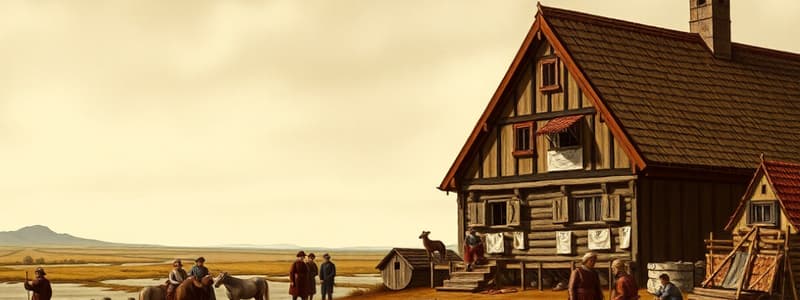Podcast
Questions and Answers
Which of the following best describes the primary impact of the Little Ice Age on European agriculture?
Which of the following best describes the primary impact of the Little Ice Age on European agriculture?
- Improved soil fertility and increased land availability for farming.
- Shift towards more diverse agricultural practices, increasing overall production.
- Significant decrease in crop yields due to shortened growing seasons and adverse weather. (correct)
- Introduction of new, more resilient crop varieties.
The famine in Europe between 1315 and 1317, linked to the Little Ice Age, was primarily a consequence of:
The famine in Europe between 1315 and 1317, linked to the Little Ice Age, was primarily a consequence of:
- Widespread livestock diseases decimating animal populations.
- Political instability and wars disrupting trade routes.
- Reduced agricultural output leading to food shortages. (correct)
- Increased demand for food due to population growth.
Ergot blight, a potential consequence of the conditions during the Little Ice Age, is associated with which of the following historical phenomena?
Ergot blight, a potential consequence of the conditions during the Little Ice Age, is associated with which of the following historical phenomena?
- The French Revolution.
- The Salem Witch Trials. (correct)
- The decline of the Roman Empire.
- The Renaissance.
How did the Black Death, which occurred after the Little Ice Age famine, primarily spread throughout Europe?
How did the Black Death, which occurred after the Little Ice Age famine, primarily spread throughout Europe?
Beyond agricultural decline and famine, the Little Ice Age also contributed to which broader societal impact in Europe?
Beyond agricultural decline and famine, the Little Ice Age also contributed to which broader societal impact in Europe?
What was a common symptom experienced by individuals infected with the plague?
What was a common symptom experienced by individuals infected with the plague?
Which of the following factors contributed significantly to the rapid spread of the plague in towns and cities?
Which of the following factors contributed significantly to the rapid spread of the plague in towns and cities?
In what way did the Black Death affect the labor force and economic structure of Europe?
In what way did the Black Death affect the labor force and economic structure of Europe?
Which of the following represents a significant long-term consequence of the plague on European society?
Which of the following represents a significant long-term consequence of the plague on European society?
How did the Black Death influence people's behaviors and beliefs?
How did the Black Death influence people's behaviors and beliefs?
Flashcards
Little Ice Age
Little Ice Age
A period of global cooling that impacted agricultural production in Europe.
Ergot Blight
Ergot Blight
A fungus that can grow on grains like rye, potentially causing hallucinations and illness.
Famine (1315-1317)
Famine (1315-1317)
Lack of adequate food supplies, widespread in Europe during the Little Ice Age.
Black Death
Black Death
Signup and view all the flashcards
Rat Flea
Rat Flea
Signup and view all the flashcards
What is the Black Death?
What is the Black Death?
Signup and view all the flashcards
What are the symptoms of the Black Death?
What are the symptoms of the Black Death?
Signup and view all the flashcards
Why did towns and cities suffer more during the plague?
Why did towns and cities suffer more during the plague?
Signup and view all the flashcards
What were the main impacts of the Black Death?
What were the main impacts of the Black Death?
Signup and view all the flashcards
What is De-urbanization?
What is De-urbanization?
Signup and view all the flashcards
Study Notes
- Before the 14th century, Europe's population grew substantially, leading to land overwork and slowed production by the late 13th century.
- A global cooling phase, with unknown causes, exacerbated the situation, causing even a small temperature drop of one degree to significantly impact agriculture.
- The Little Ice Age brought wet conditions and heavy rainfall, shortening the growing season by up to 20%.
- Traditional seeds couldn't withstand the extreme weather changes and moisture, resulting in a shortage of usable crops.
- Vital crops like wheat and rye suffered a major production decline across Europe due to the Little Ice Age.
- Snow cover lasted longer in springtime, fostering crop-devastating parasites.
- Shortages of hay led to the substitution of straw or pine for livestock feed.
- Livestock was slaughtered to feed starving populations amidst declining crop production.
- Famine spread across Europe from about 1315 to 1317, causing population decline.
- Cool, moist conditions fostered illnesses that caused gangrene or death in entire villages.
- Grains stored in these conditions could develop fungi or ferment, potentially causing hallucinations.
- Ergot blight, a grain fungus, may have contributed to the Salem witch hunt hysteria in 1692.
- The Little Ice Age led to a decline in wine production, farm destruction, reduced tax collection, and decreased property values.
The Black Death
- The Black Death began around 1347 and devastated Europe, wiping out at least a third of the population in less than a decade.
- Spread by rat fleas, the Black Death (or plague) could kill a person within five days.
- Symptoms included high fever, diarrhea, delirium, swollen lymph nodes, and black splotches on the skin.
- Victims also suffered bleeding in their lungs, nausea, vomiting, muscle pains, and disorientation.
- Treatments included draining swollen areas or administering arsenic, lily root, or dried toad.
- Cities experienced higher infection rates due to close living quarters and lack of knowledge about contagious disease spread.
- Improper disposal of bodies and a lack of protective garments for those handling them worsened the situation.
- Towns were dirty with plentiful rats carrying diseased fleas, which spread the disease rapidly.
- People blamed witches, astrology, or religious groups for the plague due to a lack of medical knowledge.
- The plague encircled Europe within about five years before disappearing.
Impacts
- The Little Ice Age, famine, and the Black Death led to significant population decline.
- The population did not recover to pre-plague levels until after 1500.
- De-urbanization occurred as people realized the plague spread more easily in cities.
- People became more isolated and embraced extreme religious beliefs to quell their fear.
- Many people donated possessions and land to the Church in exchange for protection from illness.
- Many doubted the healing power of the clergy against illness.
- Groups engaged in behaviors outlawed by the Church, such as drinking, gambling, gluttony, and extravagance.
- The workforce decreased significantly, causing the cost of labor to skyrocket.
- The feudal system began to decline, granting peasants more freedom and land.
- Aristocrats' attempts to restore feudalism led to peasant revolts.
- Agricultural life evolved into industrial systems as European towns repopulated.
- Medical sciences developed due to the plague.
- Education emphasized anatomy and science more after the plague wiped out many doctors and priests who practiced healing by faith and superstition.
Studying That Suits You
Use AI to generate personalized quizzes and flashcards to suit your learning preferences.




